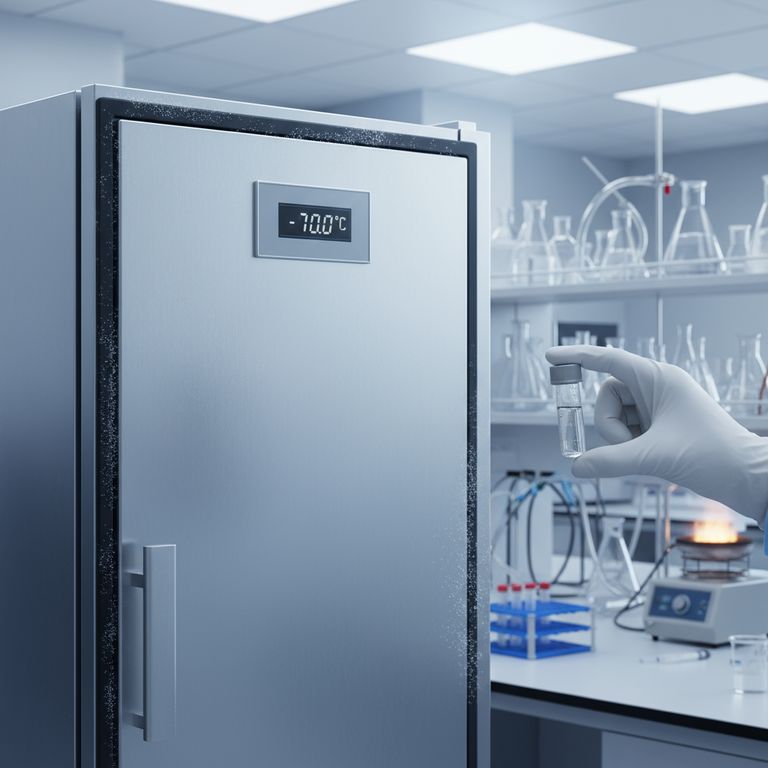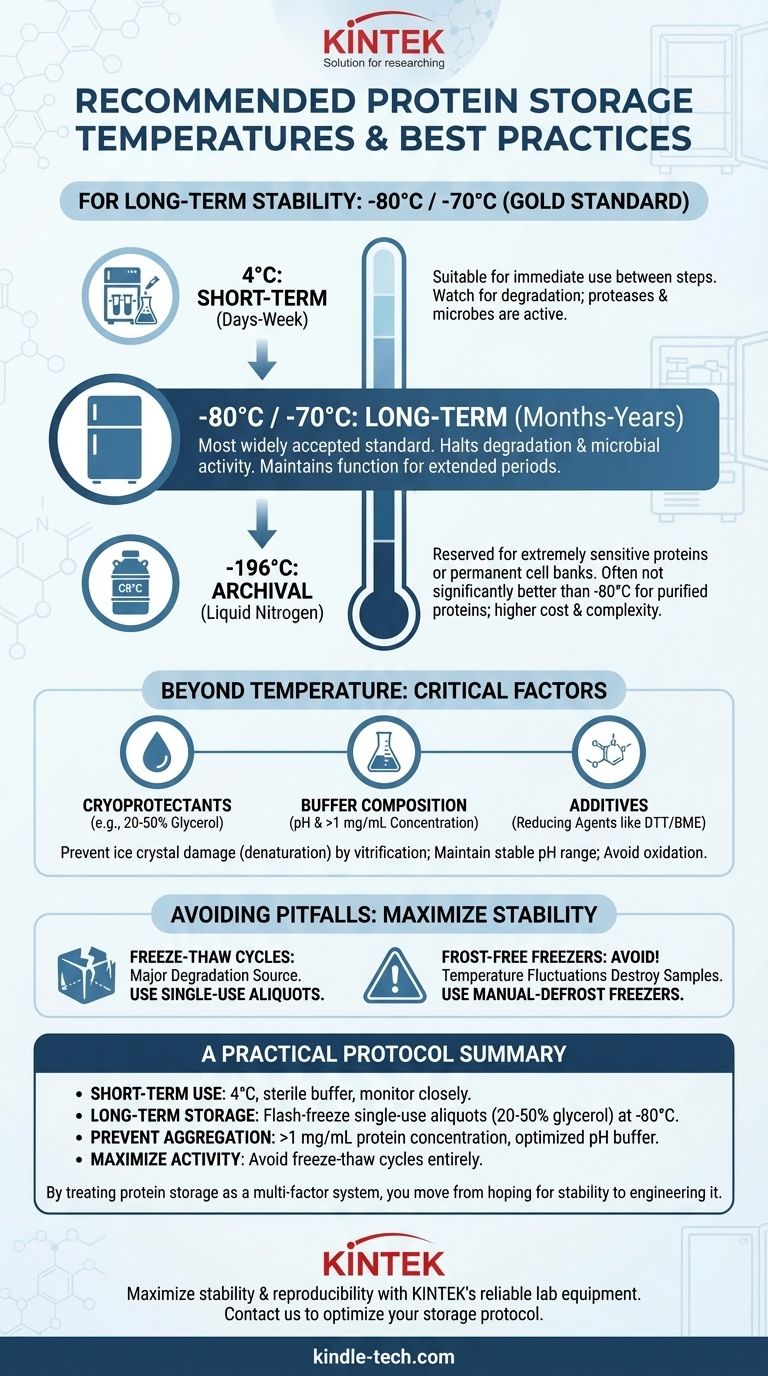For long-term stability, the most widely accepted temperature for storing purified proteins is -80°C or -70°C. This temperature effectively halts most biochemical degradation and microbial activity, preserving protein function for months or even years. However, temperature is only one component of a successful storage strategy.
Your choice of storage temperature is a critical starting point, but true protein stability depends on a combination of factors, including the protein's intrinsic properties, buffer composition, and the avoidance of damaging freeze-thaw cycles. Simply choosing a temperature without considering the full context is a common and costly mistake.

The Foundation of Protein Storage: Temperature
The primary goal of low-temperature storage is to slow down molecular motion. This dramatically reduces the rates of chemical degradation, proteolysis, and aggregation that would otherwise destroy your sample at room temperature or even in a refrigerator.
The Gold Standard: -80°C / -70°C
For storage lasting more than a few weeks, a standard laboratory -80°C freezer is the recommended solution. As the reference study indicates, this temperature is sufficient to maintain protein activity for at least a year for many common proteins.
It strikes an optimal balance between preserving the sample and the practical availability of equipment in most research environments.
Short-Term Storage: 4°C
Storing proteins at 4°C is only suitable for very short periods, typically from a few days to a week. This is common practice between purification steps or for a protein that is in constant use.
Be aware that at 4°C, proteases and microbes are still active, and degradation can occur. Samples should be sterile and may require protease inhibitors.
The Extreme Option: -196°C (Liquid Nitrogen)
Storing samples in liquid nitrogen is generally reserved for extremely sensitive proteins or for creating a permanent archival cell bank.
While it seems intuitive that colder is always better, many studies conclude that for most purified proteins, the stability at -196°C is not significantly better than at -80°C. The added complexity and cost are often not justified.
Beyond Temperature: Critical Factors for Stability
Temperature alone will not guarantee stability. The solution your protein is in is just as important as the freezer it is in.
The Importance of Cryoprotectants
When an aqueous solution freezes, ice crystals form. These crystals can physically damage protein structure through denaturation. Cryoprotectants are additives that prevent the formation of these damaging crystals.
The most common cryoprotectant is glycerol, typically added to a final concentration of 20-50%. It ensures the sample vitrifies (turns into a glass-like solid) instead of crystallizing.
The Role of Buffer Composition
A protein is only stable within a specific pH range. Your storage buffer must be formulated to maintain this pH. A buffer concentration of 20-50 mM is typical.
Furthermore, protein concentration matters. As a rule of thumb, storing proteins at a concentration above 1 mg/mL helps prevent loss due to surface adsorption to the storage tube.
Additives for Longevity
For proteins sensitive to oxidation, especially those with free cysteine residues, adding a reducing agent like Dithiothreitol (DTT) or β-mercaptoethanol (BME) to the storage buffer can be essential.
Understanding the Trade-offs and Common Pitfalls
Avoiding common mistakes is as important as following best practices. Many protein samples are ruined not by poor long-term storage, but by improper handling.
The Danger of Freeze-Thaw Cycles
This is the single most common cause of protein degradation. Each time a sample is frozen and thawed, it is exposed to the damaging effects of ice crystal formation.
The best practice is to aliquot the protein into small, single-use volumes after purification. This allows you to thaw only what you need for a single experiment, preserving the integrity of the master stock.
The "Frost-Free" Freezer Trap
Never store valuable proteins in a consumer-grade, "frost-free" freezer. These units undergo periodic warming cycles to melt ice, and these temperature fluctuations are disastrous for protein stability.
Only use manual-defrost laboratory-grade freezers that maintain a stable temperature.
Over-reliance on Temperature
Believing that a -80°C freezer is a magic bullet is a frequent error. A protein in a suboptimal buffer will still aggregate and degrade, albeit more slowly. A holistic approach considering buffer, additives, and handling is required.
A Practical Protocol for Protein Storage
To ensure the long-term viability of your sample, you must align your storage strategy with your experimental goals.
- If your primary focus is short-term use (days to a week): Store your protein at 4°C in a sterile buffer, but monitor closely for any signs of precipitation or activity loss.
- If your primary focus is standard long-term storage (months to years): Flash-freeze single-use aliquots in a buffer containing 20-50% glycerol and store them at -80°C in a manual-defrost freezer.
- If your primary focus is to prevent aggregation: Ensure the protein concentration is sufficiently high (>1 mg/mL) and that the buffer pH is optimized for your specific protein's stability.
- If your primary focus is to maximize activity: Prepare small, single-use aliquots to completely avoid freeze-thaw cycles, as this is the most significant source of damage.
By treating protein storage as a multi-factor system, you move from hoping for stability to engineering it.
Summary Table:
| Storage Temperature | Recommended Use | Key Considerations |
|---|---|---|
| -80°C / -70°C | Long-term (months to years) | Gold standard; halts degradation. Use with cryoprotectants like glycerol. |
| 4°C | Short-term (days to a week) | Suitable for immediate use; monitor for degradation. |
| -196°C (Liquid Nitrogen) | Archival (extremely sensitive proteins) | Complex and costly; often not necessary for most proteins. |
Maximize your protein stability and experimental reproducibility with KINTEK's reliable lab equipment. Proper storage is just one part of the equation—having the right tools ensures your proteins remain viable and active. KINTEK specializes in laboratory freezers, consumables, and storage solutions designed for sensitive biological samples like proteins. Whether you need a stable -80°C freezer, cryogenic vials, or expert advice on optimizing your storage protocol, we are here to support your research. Don’t let improper storage compromise your results—contact our team today to find the perfect solution for your laboratory needs!
Visual Guide

Related Products
- 58L Precision Laboratory Ultra Low Temperature Upright Freezer for Critical Sample Storage
- 608L Essential Laboratory Ultra Low Temperature Freezer For Critical Sample Preservation
- 408L Advanced Vertical Laboratory Ultra Low Temperature Freezer for Critical Research Material Preservation
- 108L Vertical Ultra Low Temperature ULT Freezer
- 28L Compact Upright Ultra Low Temperature Freezer for Laboratory
People Also Ask
- What are the common designs of ultra-low temperature freezers? Upright vs. Chest Models for Your Lab
- What factors should be considered when selecting an ultra-low temperature freezer? Ensure Sample Integrity and Long-Term Value
- How do Ultra-Low Temperature freezers ensure the integrity of microbiological samples? Maintain Stability for Critical Research
- What temperature range do Ultra-Low Temperature (ULT) freezers typically maintain? Preserve Your Samples from -40°C to -86°C
- What temperature range do Ultra-Low Temperature freezers maintain? The -80°C Standard for Sample Integrity



















